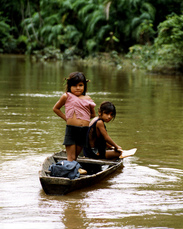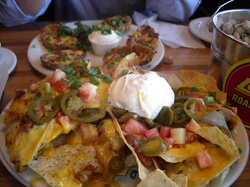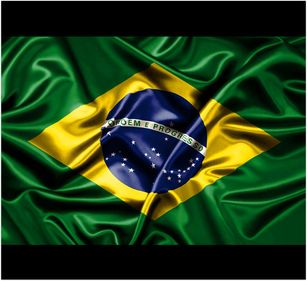A Little History about Middle and South America!

" A slow death will occur. Water will be poorer. Trees will be cut. We will loose our culture, our language, alcoholism will increase, as will marriages to outsiders, and eventually we will disperse to other areas. There is no other way. We will negotiate, but these things will happen." Chief of the Secoya proclaimed. (World Regional Geography, 4th edition. Page 115) Like the Secoya, indigenous people all over the world had to bear consequences from development. This quote was from the Chief of a little indigenous culture down the Aguarico River in South America. They were negotiating with a U.S. oil company, Occidental Petroleum. Their plans were to drill in the Secoya lands to remove oil. The Oil revenue supplied 40% of the Ecuadorian budget, and they needed the money to pay off their national debt. Later on, after more development of oil refineries, U.S. company Texaco (first major oil company to have operations in Ecuador.) pipelines had leaked almost 17 million gallons of oil into the Amazon Basin.
There are 29 countries in Middle and South America.
Climate: The climate in Middle and South America can be mostly summed up according to Temperate-Altitude Zones. As the altitude increases in these zones, the temperature decreases. About 1 degree Fahrenheit per 300 feet. (1 degree Celsius per 165 meters).
Below will show you the temperate Zones and what agricultural resources are usually found in them.
Climate: The climate in Middle and South America can be mostly summed up according to Temperate-Altitude Zones. As the altitude increases in these zones, the temperature decreases. About 1 degree Fahrenheit per 300 feet. (1 degree Celsius per 165 meters).
Below will show you the temperate Zones and what agricultural resources are usually found in them.
Temperate-Altitude Zone
Tierra Caliente: "hot land" extends to about 3000 feet in elevation. Moisture is adequate, tropical rain forest thrives. These lowlands in some areas can cover wide expanses.
Tierra Templada: "temperate lands" Between 3000 and 6500 feet of elevation. Has a spring like climate, which enables most indigenous people to live here.
Tierra Fria: "cool lands" Between 6500 and 12,000 feet. Several modern population centers are here, including Mexico City, and Quito, Ecuador.
Tierra Helada: "frozen lands" Above 12,000 feet. Lowest attitudes of this zone may contain some cultivated vegetation. Higher up all-though, vegetation is almost nothing, and there are mountain tops emerging from the glaciers and snow.
*Trade Winds: (wind patterns) that influence the climate and precipitation. Winds from the Atlantic bring seasonal rains, winds from the Pacific bring seasonal rains to the west coast of Central America , but the mountains block the rain from getting to the Caribbean side.
Tierra Templada: "temperate lands" Between 3000 and 6500 feet of elevation. Has a spring like climate, which enables most indigenous people to live here.
Tierra Fria: "cool lands" Between 6500 and 12,000 feet. Several modern population centers are here, including Mexico City, and Quito, Ecuador.
Tierra Helada: "frozen lands" Above 12,000 feet. Lowest attitudes of this zone may contain some cultivated vegetation. Higher up all-though, vegetation is almost nothing, and there are mountain tops emerging from the glaciers and snow.
*Trade Winds: (wind patterns) that influence the climate and precipitation. Winds from the Atlantic bring seasonal rains, winds from the Pacific bring seasonal rains to the west coast of Central America , but the mountains block the rain from getting to the Caribbean side.
Crops in Temperate-Altitude Zone
"Dry Forest": Cacao, Banana's, Sugarcane, Tobacco, Pineapple.
"Wet Forest": Corn, beans, squash, cotton, coffee, various green vegetables.
"Cloud Forest": Wheat, fruit trees, and root vegetables (potatoes, onions and carrots.) Cabbage, and broccoli.
"Elfin Forest". Some grains and vegetables, also you may find Llamas, sheep and Guinea pigs.
"Wet Forest": Corn, beans, squash, cotton, coffee, various green vegetables.
"Cloud Forest": Wheat, fruit trees, and root vegetables (potatoes, onions and carrots.) Cabbage, and broccoli.
"Elfin Forest". Some grains and vegetables, also you may find Llamas, sheep and Guinea pigs.
Resources:
- Brazil - bauxite, gold, iron ore, manganese, nickel, phosphates, platinum, tin, uranium, petroleum, hydro-power, timber.
- Mexico - petroleum, silver, copper, gold, lead, zinc, natural gas, timber.
- Argentina - lead, zinc, tin, copper, iron ore, manganese, petroleum, uranium.
- Colombia - petroleum, natural gas, coal, iron ore, nickel, gold, copper, emeralds, hydro-power.
- Venezuela - petroleum, natural gas, iron ore, gold, bauxite, hydro-power, diamonds.
- Middle America -has fertile soil, oil, natural gas, silver, rich gold.
Religions In Middle and South America: The Roman Catholic church is the most influential institutions in Middle and South America today. From the beginning the church was always a major roll in culture with the Spanish and Portuguese colonial governments and people. The Catholic church helped civilize colonies and converted indigenous people. Helped colonies to accept low status, be obedient to the authorities, and to postpone rewards until Heaven.
Evangelical Protestantism diffused into Middle and South America from North America and it is now the fastest growing religion, it appeals to the urban and the poor unlike the original Catholicism.
Evangelical Protestantism diffused into Middle and South America from North America and it is now the fastest growing religion, it appeals to the urban and the poor unlike the original Catholicism.
Population Patterns: 30,000 to 14,000 years ago hunters and gatherers mainly from North East Asia. 50-100 million years ago the indigenous people in Middle and South America, upon the largest were the Incas. 500 years of European dominance. As of 2005, 560 million people were living in Middle and South America. The population growth was the highest in the twentieth century.
Family Gender Roles in Middle and South America:

Priority is in Chasity, Motherhood and Service to the family.
Ideal Women- is the day-to-day manager of the household and the family's well-being. Training in their son's to enter the wider world and daughters to serve with in the home. A woman's power increases as her skills and sacrifices for the good of all are recognized and enshrined in family love.
Ideal Male- titular family head, expected to work and provide income to the family. Generally have more freedom then the women to shape their lives. Expected to improve their social lives and to make their family "higher up on the totem pole". With their freedom they are expected to move about the community and establish personal relationships, economical relationships. Men have more lenience with socializing with the opposite gender than the women of the family do. buses
Children- despite the fact that the families try to do all they can for their children to have a better life, many families need the income that even young children can generate. About one third of the children in Middle and South America are economically active. Working in small jobs like agriculture, logging, and mining. City children often work selling items in the streets like fruits and chewing gum, flowers, flip-flops, cleaning cars, and preforming small services.
Ideal Women- is the day-to-day manager of the household and the family's well-being. Training in their son's to enter the wider world and daughters to serve with in the home. A woman's power increases as her skills and sacrifices for the good of all are recognized and enshrined in family love.
Ideal Male- titular family head, expected to work and provide income to the family. Generally have more freedom then the women to shape their lives. Expected to improve their social lives and to make their family "higher up on the totem pole". With their freedom they are expected to move about the community and establish personal relationships, economical relationships. Men have more lenience with socializing with the opposite gender than the women of the family do. buses
Children- despite the fact that the families try to do all they can for their children to have a better life, many families need the income that even young children can generate. About one third of the children in Middle and South America are economically active. Working in small jobs like agriculture, logging, and mining. City children often work selling items in the streets like fruits and chewing gum, flowers, flip-flops, cleaning cars, and preforming small services.
Environmental Issues in Middle and South America:
- Environmental Degradation: Mainly in Central America. This is caused by large scale agriculture which is causing a lot of erosion.
- Agriculture: Clearing a lot of land for crops and cattle, especially seen in Costa Rica, which is the leader in Environmental Movement that was established in Central America. In the 1980's they established Wetland parks to keep the precious land untouched by agriculture, as well as to promote ecotourism. So far 175 Parks have been established.
Transportation:
Example: Curitiba.
Minibuses: 1100 buses making 12,000 trips a day that bring 1.3 million people from neighborhoods to terminals where they meet different express buses that bring them to different parts of the city every day.
Walking: There is fifty square blocks that are pedestrian only in the inner city. This way people are allowed to spend more time shopping and less time trying to park.
Cars: Many people own their own vehicle transportation.
They also have planes, trains, and boats, and car rentals for tourists and everyday people, such as we do.
Example: Curitiba.
Minibuses: 1100 buses making 12,000 trips a day that bring 1.3 million people from neighborhoods to terminals where they meet different express buses that bring them to different parts of the city every day.
Walking: There is fifty square blocks that are pedestrian only in the inner city. This way people are allowed to spend more time shopping and less time trying to park.
Cars: Many people own their own vehicle transportation.
They also have planes, trains, and boats, and car rentals for tourists and everyday people, such as we do.
Cuisine in Middle and South America

Because of the warm climate and prime weather for agriculture, Middle and South America has a lot of options for their cooking. They have a plethora of vegetables and fruits to choose from when making a favorite meal. Native vegetation such like, passion fruits, avocado, papaya, squash, such as the chayote, and starchy roots and tubers like yucca, pineapple, strawberries, tomatoes, hot peppers, green red and yellow peppers, chili peppers, jalapenos, sweet potatoes, potatoes, corn. Most meals usually contain a side dish of beans and/or rice of some sort. Usually with meat, beef, pork, or chicken. Without surprise with the ocean and rivers they have plentiful amounts of fish and seafood to enjoy. Also on some occasions, llama's and guinea pigs are breed in the higher altitudes for a source of protein. They also have the coffee bean which is native in the area, so that is also very common. Salsa and chips, spicier foods, tacos, burritos, tortillas, are all examples of foods that came from the cultural aspect of Middle and South America that we have incorporated into our diets today.
Country of Focus: Brazil.

Brazil is about the same area as the United States.
One of the main features throughout Brazil is the Amazon Basin. The income in Brazil compared to the rest of the world is interesting because Brazil has the biggest difference between the Rich and the Poor. The richest 20 percent of Brazil's population has 26 times the wealth then the poorest 20 percent of Brazil.
Tourists are delighted with the creativity and elegance of the Brazilian people but, sobered by the obvious hardships under which they labor.
Brazil has three distinctive features, the Amazon Basin, the Mato Grosso, and the Brazilian Highlands.
Brazil also has a number of large cities, a few of which are Rio de Janerio, Curitiba, Sao Paulo, Salvador, Recife, Fortaleza, Belem, and Brasilia. Brasilia is now the modern capital of Brazil.
One of the main features throughout Brazil is the Amazon Basin. The income in Brazil compared to the rest of the world is interesting because Brazil has the biggest difference between the Rich and the Poor. The richest 20 percent of Brazil's population has 26 times the wealth then the poorest 20 percent of Brazil.
Tourists are delighted with the creativity and elegance of the Brazilian people but, sobered by the obvious hardships under which they labor.
Brazil has three distinctive features, the Amazon Basin, the Mato Grosso, and the Brazilian Highlands.
Brazil also has a number of large cities, a few of which are Rio de Janerio, Curitiba, Sao Paulo, Salvador, Recife, Fortaleza, Belem, and Brasilia. Brasilia is now the modern capital of Brazil.
Sources
Pulsipher, L.M., and Pulsipher, A. (2008). World Regional Geography: Global Patterns, Local Lives (4th ed.) Pages 115-183. New York: W.H. Freeman and Company.
Denise Balkissoon. (2011). The Tastes of Central America. Retrieved from, http://www.foodnetwork.ca/guides/global-cuisine/south-america/Tastes+Central+America/2177864/story.html
Pulsipher, L.M., and Pulsipher, A. (2008). World Regional Geography: Global Patterns, Local Lives (4th ed.) Pages 115-183. New York: W.H. Freeman and Company.
Denise Balkissoon. (2011). The Tastes of Central America. Retrieved from, http://www.foodnetwork.ca/guides/global-cuisine/south-america/Tastes+Central+America/2177864/story.html
